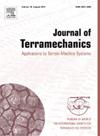软地形运动仿生步行机器人力学模型的建立
IF 3.7
3区 工程技术
Q3 ENGINEERING, ENVIRONMENTAL
引用次数: 0
摘要
仿生行走机器人在刚性地形上表现出优异的机动性。然而,它们在软地形上的通行性仍然是影响其整体性能的重大挑战。为了解决这一问题,我们首先建立了仿生步行机器人的运动学模型,推导了足垫与软地之间的运动参数。随后,建立了脚垫-地形相互作用模型,分析了机器人在软地形上运动时所受的力。在多用途单足试验台上,搭建了机器人样腿,对3个不同行走速度的脚垫进行了实验测试,记录了脚垫与地形相互作用的各个阶段,测量了垂直力F1和水平力F2。结果表明,该模型预测力的准确度在90%以上。实验值和模型值之间的最小差异表明,力学模型对力分析是可靠的。因此,本研究建立的力学模型可以进一步确定脚垫所受的力,并定义力矩和下沉,为了解步行机器人的稳定性提供布局基础。本文章由计算机程序翻译,如有差异,请以英文原文为准。
Mechanical model building of bionic walking robot in motion with soft terrain
Bionic walking robots exhibit excellent mobility on rigid terrain.
however, their trafficability on soft terrain remains a significant challenge affecting their overall performance. To address this issue, we firstly developed a kinematic model of a bionic walking robot to derive the motion parameters between the footpad and soft terrain. Subsequently, a footpad-terrain interaction model was established to analyze the forces acting on the robot during its movement on soft terrain. An exemplar robot leg was built and three footpads at various walking speed were experimentally tested using a versatile single-legged test bench, various stages of footpad-terrain interactions were recorded and vertical force F1 and horizontal force F2 were measured. The results confirmed that the model could predict the forces with an accuracy greater than 90 %. The minimal differences observed between the experimental and model values suggest that the mechanical model is reliable for force analysis. Therefore, the mechanical model developed in the study could be further determine the forces exerted on the footpads at and defined moments and sinkage, and a layout foundation to understand the stability of walking robots.
求助全文
通过发布文献求助,成功后即可免费获取论文全文。
去求助
来源期刊

Journal of Terramechanics
工程技术-工程:环境
CiteScore
5.90
自引率
8.30%
发文量
33
审稿时长
15.3 weeks
期刊介绍:
The Journal of Terramechanics is primarily devoted to scientific articles concerned with research, design, and equipment utilization in the field of terramechanics.
The Journal of Terramechanics is the leading international journal serving the multidisciplinary global off-road vehicle and soil working machinery industries, and related user community, governmental agencies and universities.
The Journal of Terramechanics provides a forum for those involved in research, development, design, innovation, testing, application and utilization of off-road vehicles and soil working machinery, and their sub-systems and components. The Journal presents a cross-section of technical papers, reviews, comments and discussions, and serves as a medium for recording recent progress in the field.
 求助内容:
求助内容: 应助结果提醒方式:
应助结果提醒方式:


